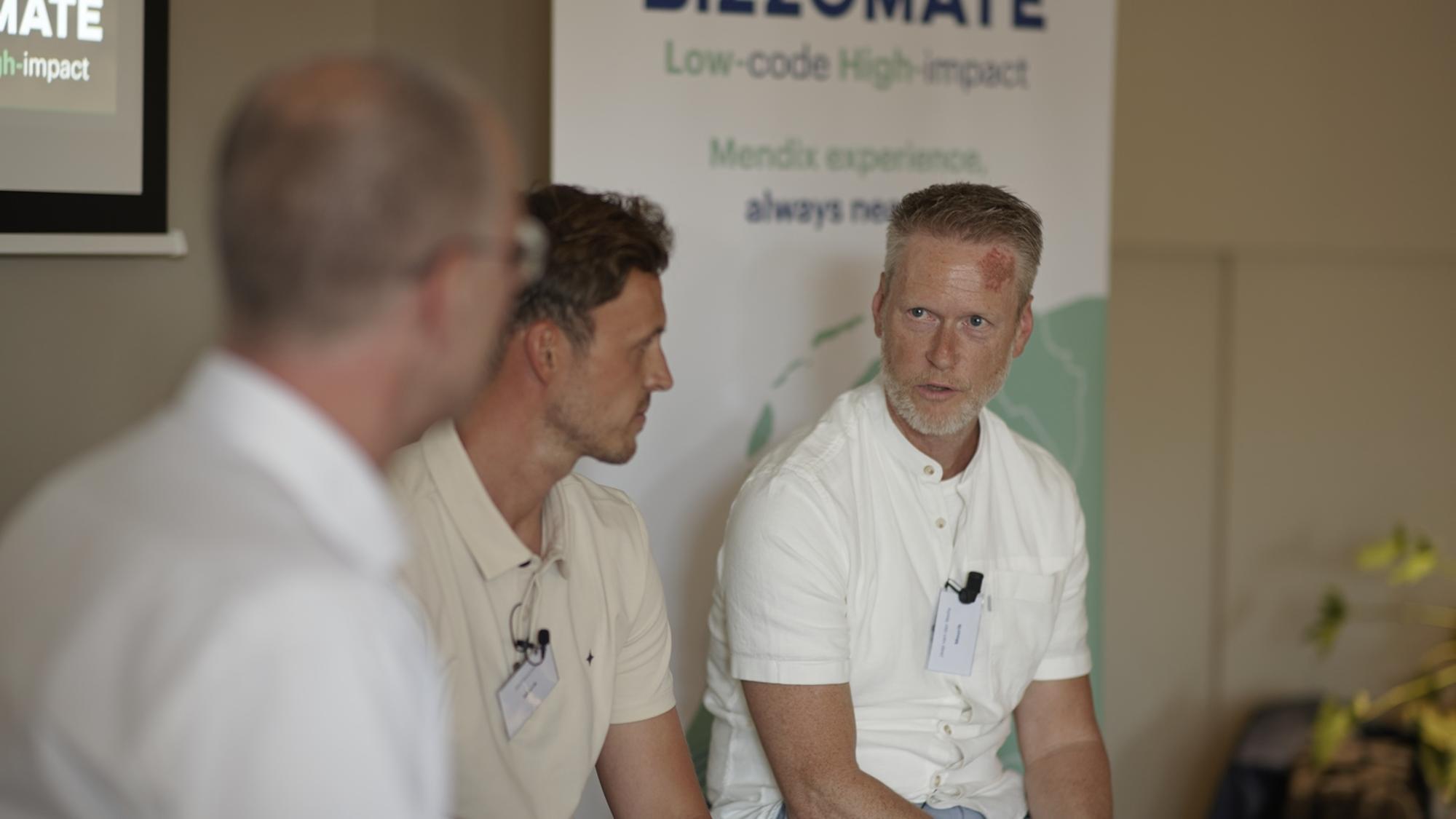Bizzo Meet & Mx press release: Taking Low-Code to the next level
24 January 2024 • News

What steps should you take to advance low-code projects in your organization beyond the start-up phase? And how do you ensure that these trajectories do not end prematurely? To successfully get the acceleration of low-code off the ground in your organization, it is crucial that you create a “growth culture” within your team, that you develop a low-code vision that you also communicate, and that you have the guts to get out of your comfort zone to seek out new challenging low-code projects. Those are the three main conclusions coming out of the Bizzomate event “taking low-code to the next level” on June 13 in Culemborg.
For the event, Bizzomate invited dozens of SMBs that had just completed their first low-code projects or were just starting to further integrate low-code into their organizations. Marc Gelissen, CEO and founder of Bizzomate welcomed the guests and then turned the floor over to Brian Farley. He is the baseball coach who amazed the world in 2011 by winning the World Baseball Championship with the Dutch national team seemingly out of nowhere by beating arch-rival Cuba 2-1 in a thrilling final.
A growth-oriented culture is indispensable for top performance
Brian knows better than anyone how to turn a team into a truly top team; not insignificant if you and your IT team want to take low-code to the next level in your organization. If you want to achieve top performance, Brian says there are a number of prerequisites that must be met. Most importantly, team members should all feel that they matter, that each of them is important to the team.
Brian outlines three ways you can accomplish this with your team. The first is through authentic leadership. If you are the leader of a team, it is up to you to always ask yourself how you can help others grow in your role. What qualities of yourself can you use for this purpose? And how can you create a place where people feel safe? The mindset you have in this regard largely determines the atmosphere within the team. If you as a leader have a positive mindset, so does the team because positivity is contagious.
The second is to dare to show your true ego. Many people behave a certain way in order to be part of a team. This is understandable, but not authentic behavior. If the leader of the team shows that people with all sides of their ego can feel seen and heard in the team it makes a big difference. Team members who feel this way perform much better. The third way is by really listening to each other in a team.
It is these preconditions that ultimately determine team culture. Together, they determine whether a culture of fear or a culture of growth emerges in your team. Brian believes that only in a growth culture can team members ultimately get the best out of themselves. In a culture of fear, people will be primarily concerned with avoiding punishment. In the short term, that may work, but in the longer term, no one keeps it up.
In a growth culture, overcoming obstacles and sharing mistakes is actually seen as a challenge to achieve further growth with the team. Only in a growth culture do team members together find the courage to get out of their comfort zone.
The “stretch zone” is where you want to be
The zone you then want to get into is “the stretch zone. In it, you do something that is just beyond your current skill set, but which you can achieve. If you set your goals too high, you end up in the “panic zone” where your goals are so unachievable that team members start saying, “we’re never going to make it anyway. If you manage to get into the “stretch zone” with your team and achieve your goals, this forms core fulfillment, happiness and connection in a team.
Brian closes his story with a great message: Start with yourself. Ask yourself every day what impact you want to make on your colleagues and teammates. If everyone on a team does that, you end up with a top-notch team.
Vision of the role of low-code in the organization crucial
If you want to take low-code to the next level in your organization, you need not only an excellent team, but also a thoughtful vision of the role low-code should play in your organization.
Arjo van Oosten elaborates on that. He is VP of Digital Transformation at Mendix and the founder of the Mendix digital transformation framework, a step-by-step framework for successfully implementing digital transformation strategies.
He reveals that a survey by consulting firm McKinsey found that only 16% of IT leaders consider their organization’s digital transformation a success. One reason for this is the lack of a clear vision for low-code. According to Arjo, the maturity of your low-code vision helps determine the ultimate success of low-code in your organization.
A low-code vision can take place at three levels. It can be limited to just a project. These are often organizations that are just seeing if low-code is interesting to them. What follows is a low-code vision for the program, a phase when the organization understands and endorses the value of low-code, but does not yet know exactly how low-code fits into the organization and ecosystem. Ultimately, you want to move toward a vision where low-code is seen as key to achieving strategic goals, beating the competition, and creating new business models in the organization.
So why is a low-code vision so crucial? Arjo explains that having and articulating a vision for low-code creates the right focus. Team members thus know better which projects qualify as low code and which do not. In addition, it also provides connection. Once the goals are clear, there is nothing finer than working with your team to achieve the desired goals. And it also works to inspire others so that they will constantly be “on” for spotting possible other interesting low-code projects within the organization.
Not 4 but 5 P’s
To actually successfully implement your vision of low-code as a CIO, Mendix has listed the fundamentals for successful digital transformation with low-code These are the 4 P’s, people, process, portfolio and platform. Recently, a fifth “P” was added, the “P” of Promotion. As CIO, if you have successfully completed your first low-code project, make sure everyone in the organization knows about it. Document the value of your first projects as well. This makes it easier at a later stage to explain the value to the business. This way, low-code becomes more alive in the organization and you can more easily advance to the structure phase.
The deployment of low-code at Mourik
Two IT professionals who can talk about how to grow low-code in your organization are Stef Koomans, low-code program manager and Jaap van der Welle, CIO of Mourik. This is a large B2B service provider whose activities include infrastructure projects such as dike reinforcement and road and bridge maintenance. They have now completed the initial phase of their digital transformation process with low-code. In an interview with Marc Gelissen and look back on their experiences in the first phase.
In doing so, Stef reiterates the importance of starting with a small but successful low-code application. For example, they built a small application for sustainability week at Mourik. In addition, an application was built in which employees in projects can track emissions. Jaap stresses the importance of an initial project with good colleagues who are really in the business, preferably in management. This makes it easier to get a lot of internal promotion for the low-code projects right away, making it really live in the organization and building on its success.
Another key point to accelerate the growth of low-code projects is to perform a baseline measurement when building the first applications. This then makes it easier to show business value. New low-code projects in the organization are then easier to get off the ground.
Jaap and Stef see plenty of opportunities to successfully advance to the structural phase now. Managing the app portfolio so there is no proliferation of apps, building the right application infrastructure and finding additional developers in the process their main challenges. Their ultimate goal? Making money for Mourik with low-code apps they build with the team.
No growth of low-code in the organization without guts
Marc Gelissen closes the official program with a short round of questions. In doing so, Brian, Arjo, Jaap and Stef all emphasize the importance of daring to get out of your comfort zone when working with low-code. That’s where the growth opportunity is. How to do that? Think about your final destination. Where do you want to be in 10 years? The difference between where you are now and where you want to be with low-code is your main motivation for taking low-code to the next level in your organization.
Attending our next event?
Would you also like to be inspired about the possibilities of low-code for your organization? And would you like to meet a mix of thought leaders, experts and customers with real-life stories? Then leave your details here and we’ll send you an invitation to the next Meet & Mx.




